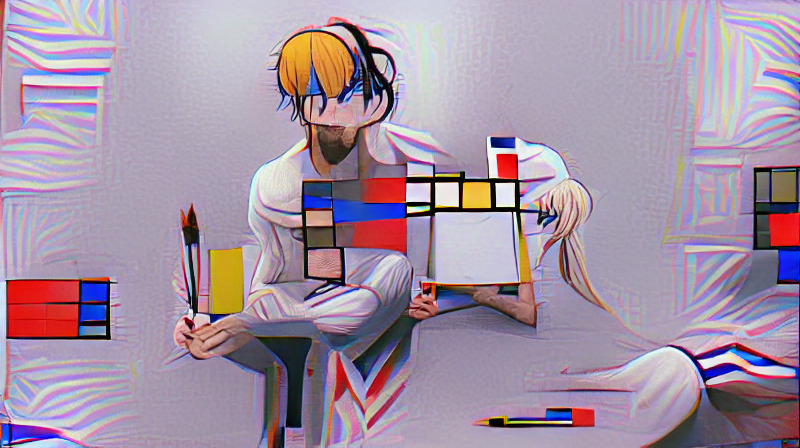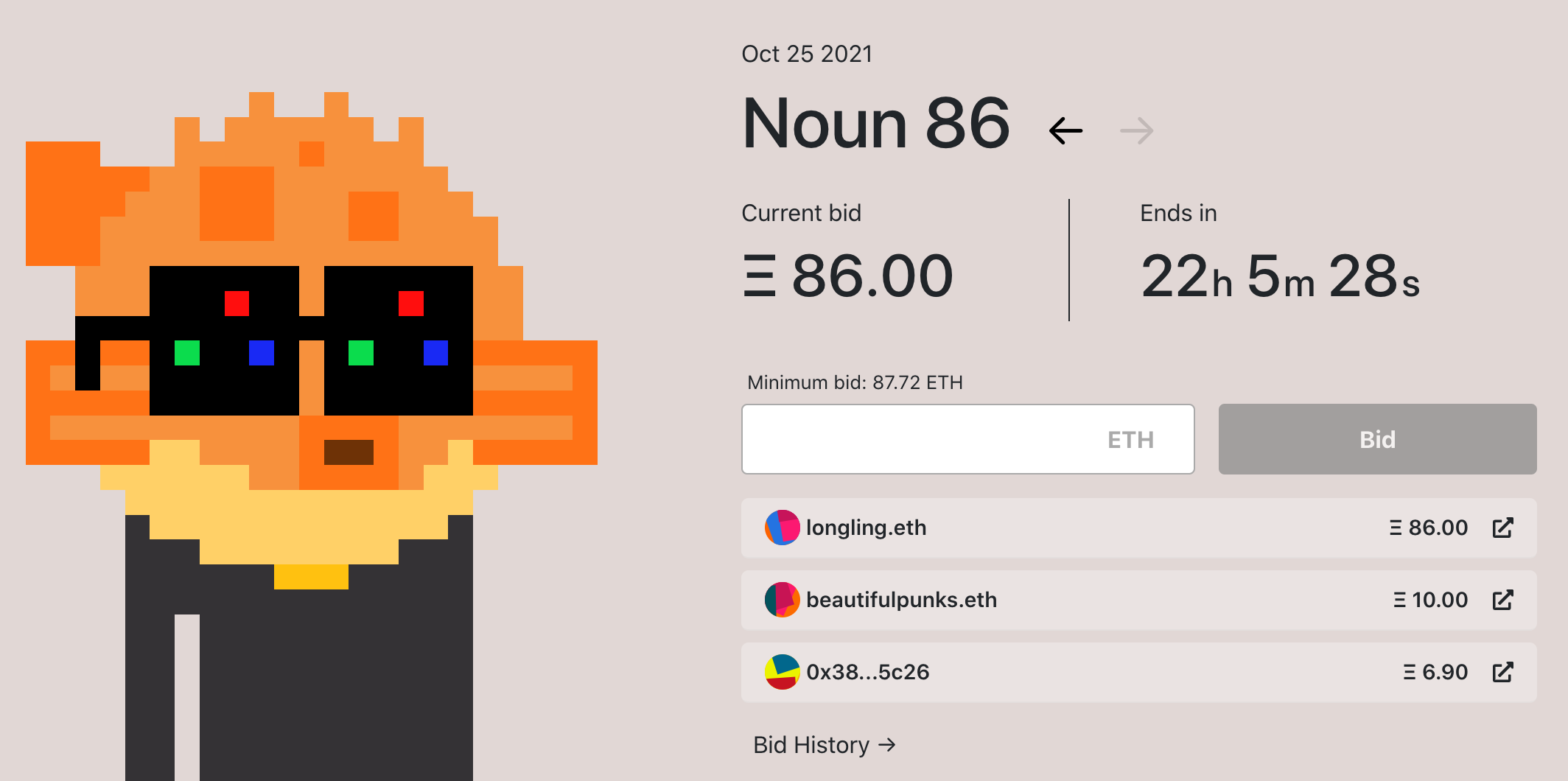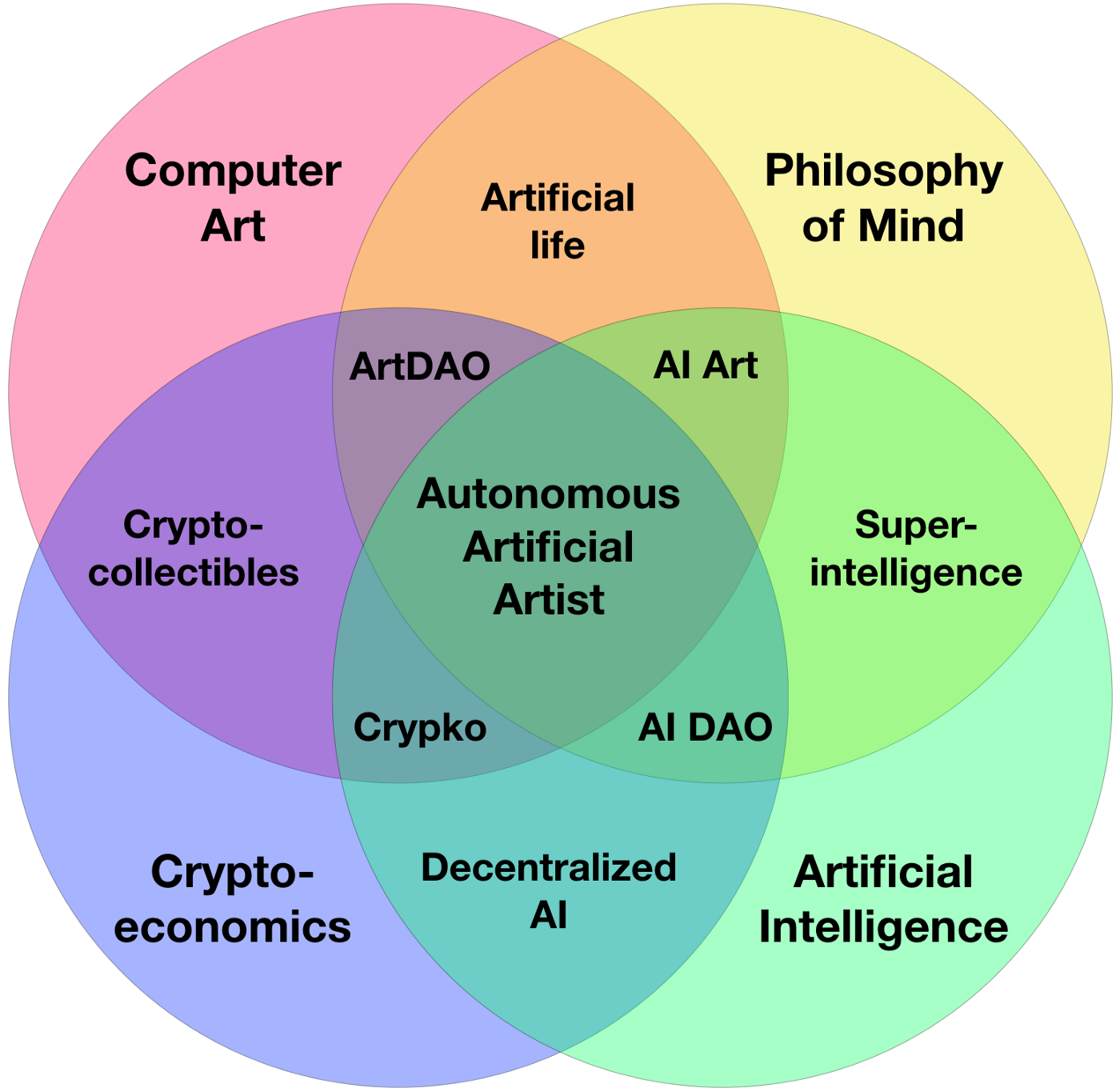Decentralized Autonomous Artists
On Oct 24, 2021, Botto, a “decentralized autonomous artist” sold its first work for ~$325,000 (79.421 ETH). Slowly, but surely, all the requisite components have matured for crypto-based autonomous artists to take center stage. We now have broader adoption in crypto, NFTs, DeFi, DAOs, GPT-3, Generative Art, & GANs. There are a handful of projects exploring this intersection, and they surely won’t be the last. Let’s delve into what they are, and what could likely happen. I’ll cover early explorations (Plantoid, AI ArtDAOs, Artonomous, Clovers) to current projects like Neolastics, Abraham, NounsDAO, & Botto.
VQGAN+CLIP drawn work by myself, with prompt: “the artist | in the style of anime | in the style of mondrian”
An Autonomous Artist
Explorations of autonomy in art is not new. It forms the basis of generative art and was pioneered by artists like Vera Molnar & Harold Cohen. Vera created algorithmic art with a plotter in the 60s, and artists like Harold created robots that drew original art since the 70s.
An original drawing from Harold Cohen’s AARON: https://computerhistory.org/blog/harold-cohen-and-aaron-a-40-year-collaboration/
Additionally, in the 90s, you had experiments like Conway’s Game of Life that played at this intersection of a ‘life’ that with simple rules, could create complex art.
What’s new in crypto-based autonomous artists is the ability to inscribe enforceable rules that allow any particular participant to step in and fulfil the required instructions. It being smart-contract based means that these autonomous artist can, ideally, in a fully closed economic substrate: create art, sell it, and incentivize participants to improve it. Throughout this process, various stakeholders can earn rewards from helping this autonomous artist succeed: either by helping it learn, promoting the works, managing its funds, & hosting its infrastructure. The most ideal outcome is that at any point, any participant could step out and step in to keep an autonomous artist alive. Now that NFTs, DeFi, and DAOs have proliferated, these modular components can be combined in many different ways to produce autonomous artists.
Plantoid (2015+)
I’d argue that Primavera De Filippi’s Plantoid was the first art project that explored art autonomy with crypto. A robotic plant has an attached QR code, whereupon new crypto funds are used to pay for the development of new ones.
A Plantoid at Burning Man
It’s fairly emergent, and has loose rules. The recipient of the funds doesn’t have to be the original creator.
You can see Primavera talk about it in 2015. The COALA Blockchain workshops she helped host is where I met the people who would inspire so many new ideas at this intersection.
Over the course of the next few years, many of crypto autonomous art projects went mostly on-chain.
AI ArtDAOs + Artonomous (2016)
In 2016, before all the components took off as it did, inspired by work in blockchain IP, Primavera’s Plantoid, and the infamous “The DAO”, Trent McGonaghy, Greg McMullen, and I, formulated a core feedback loop of a crypto-based autonomous artist. The formula is still today, fairly simple.
1) Let a program create original generative art.
2) Sell it as a digital collectible (nowadays, NFTs).
3) Improve/edit/curate the program (with baked-in economic incentives).
4) Back to square 1.
Within this simple formula are countless variations.
For step 1, creating generative art: How would this art be created? One generator? Many generators? Off-chain? On-chain? A deterministic process? A multi-party compute process? Should it be voted on? etc.
For step 2, selling the collectible: Should it be an NFT? Should it be fractionalized? How many? A set schedule? An economic schedule? A bonding curve perhaps? How frequently? Cap, or no cap?
For step 3, improving the autonomous artist: should stakeholders vote/stake towards what art should be produced? Who gets the proceeds? Should it be buy & burn? Should it go into a bonding curve? Should it go to a DAO? Should the proceeds pay for new programmers? Should the autonomous artist have its own works compete with each other?
As you can see, there’s many variations here. Trent proposed a model that accounted for infrastructure that didn’t exist yet.
My early proposals in 2016 & 2017 incorporated my work on curation markets, meme markets, and bonding curves.
In: A Software Agent Without Human Control that Produces, Owns & Sells its Own Art, the idea was to create a bonding curve token that voted on a commit hash that created a digital collectible.
In: Let’s Summon An Autonomous Artist - A Bot That Creates, Owns and Sells Its Own Art, the idea was refined to take into account my work on curation markets.
With Artonomous, I was lucky to have a host of people take the ideas and keep running with it in 2017/2018. Michael Zargham and the great team at BlockScience took some of the early ideas and modelled in into early prototypes of cadCAD. You can see some of the modelling here on Github.
A team, consisting of Tim Daubenschütz, Greg McMullen, Oz, Ian Nash, & Tarrence van As implemented a variation of Artonomous and won ETHBerlin 2018 with it. The codebase is public and open source: https://github.com/artonomous/ethberlin.
A form of Artonomous at ETHBerlin 2018: https://twitter.com/ETHBerlin/status/1038802263437918220/photo/1
Since then, there’s been attempts at exploring what exactly Artonomous should look like. Because the designs are so broad, and the work involved quite extensive, it slowly ran its course. That being said, because the exploration space is still so broad, you are welcome to go read our discussions we had on Github in 2018. We considered variations such as whether to have one or many generators, how to put the art on-chain, what auction mechanisms to use and so forth. https://github.com/artonomous/artonomous-mvp/issues.
The simplest MVP of Artonomous eventually became Neolastics.
Neolastics (2020) & Clovers (2019)
I class Neolastics & Clovers as proto autonomous artists because through their economic design, they implicitly incentivize curation of a latent generative art space. That’s why the design space is broad: the proceeds don’t have to go directly to a DAO or be used to pay programmers to improve it. Just through the economic system itself, it can curate its set.
Clovers
In Clovers, users task their browsers to explore the creation of art in the form of final states of games of Reversi. If a user generates a symmetrical end state, they can 1) choose to keep it, paying in clover coins set by the protocol, or 2) get paid by the protocol in inflated clover coins to sell it to someone else who might want it. It’s a bit more in-depth that described above, of which I wrote about it in 2019: Clovers & Continuous Economies.
So, in short it creates generative art, sells it as a collectible, and through the economic process, it incentivizes users to generate more of it. It was conceived of & developed by a team consisting of Billy Rennekamp, Nicolas Kort, Everett Williams, and Alan Woo. The code is available and open source on Github: https://github.com/clovers-network.
It was cool that cadCAD was used to help model the system.
Neolastics
Neolastics is also a generative art project I created, that’s backed by a bonding curve. In this case, the components are a bit simpler. Users can pay to generate a new piece with a simple generative art formula. The funds go into a bonding curve where any users can choose to burn/destroy their piece and get back a piece of the reserve. Thus, the supply of pieces grows and shrinks. It curates a set through this mechanism: pieces that people do not want, are destroyed. So, over a period of time, the set curates what the market decides are rare or aesthetically pleasing variations. You can see the current set on OpenSea.
What both Neolastics & Clovers lack, however, is the ability for the generative algorithm to improve itself. While it curates a set, the generator does not change over time.
NounsDAO
While on its surface, NounsDAO isn’t pretending to be an autonomous artist, it likely has the most decentralized and out-of-the-box template for it. Every day, it auctions off a new “Noun”. In its treasury, all Noun holders get to vote what to do with the funds.
So, it looks more an NFT-based DAO, but Nouns has one key feature that could change its future: you can upgrade the descriptor (which is essentially the ‘drawer’), the seeder (how it generates the input for the drawer), and the minter (how it auctions the Nouns). Although I don’t believe the community currently has this intent, it can choose to change what past & future Nouns look like. To change future Nouns, say from ID 100, the new drawer would add this extra code: “if Noun ID is over 100, then draw it using this new drawer”.
Another benefit of Nouns is that all of it is on-chain. So, that does restrict what can be drawn atm, but, it’s template can be used & re-used. The money received from proceeds can be used to pay people to create new and interesting drawers. NounsDAO has to date (25/10/2021), 12335 ETH in its treasury! Wild. It’s code is open-source and viewable on EtherScan. It was created by a group of 10 individuals (which you can see on the nouns site).
While NounsDAO can’t generate GAN imagery, it might not be entirely out of the question in the future. Projects like Kohi art exploring putting more generated imagery, all on-chain, and you could eventually have various verifiers if one chooses to add external images.
Kintsugi by Wattsy & untokyo (via Kohi)
Abraham.ai (2019+)
I would likely put Abraham, kickstarted by Gene Kogan as the most ambitious imagination of an autonomous artist. The eventual goal aims to incorporate multi-party computation of images such that one wouldn’t entirely know the mind of the autonomous artist. Most of the autonomous artist proposals thus far includes deterministic generation of art. To have an ‘artist in the cloud’, as Abraham, is described, is to also be surprised by the artist’s originality.
Notably, Abraham takes inspiration from works like Simon Colton’s “Painting Fool” that attempts to imbue a ‘philosophy of mind’ in the software artist.
Abraham is still in development, and to get to the final, fully holy-grail will likely take some time. It took 5+ years for the basics of NFT, DAOs, DeFi to materialise, it might take more time to have existing infrastructure available that can also easily handle multi-party compute for image generation.
Currently, Abraham’s web front-end for its creation are open source. Its generator is also open source.
Botto (2021)
Finally, we have Botto. A project collaboration between ElevenYellow, Carbono, & Mario Klingemann (@Quasimondo).
Botto’s first work: https://superrare.com/artwork-v2/asymmetrical-liberation-29715
Botto has a simple design. Users use a currency called BOTTO to stake and generate Voting Points (VP). With VP, each week, users choose an artwork from among 50 to mint. It is put up on auction on SuperRare, upon which the proceeds are used to reward BOTTO holders: the proceeds are used to buy BOTTO and burn it (removing it from circulation). With the votes, it trains the next set of artwork it shows to voters. Hopefully, better voting in time, increases the beauty of the art being sold.
Currently, unlike projects like NounsDAO, it still requires some manual involvement: running the generators, putting the auction up to mint, buying/burning BOTTO from proceeds and so forth. Currently, only the token contracts are open source. The generator is not open source at the moment.
Unless there’s ways to verify the input, GAN-based autonomous artists like Abraham & Botto still require manual human involvement for the time being. HT to Eponym who also has a GAN-based project where users could choose what to mint with their own words.
The Future
As crypto & AI has matured, we’re now at the right time and right place to actively play & grow with autonomous artists. The crypto substrate allows for playing in simple ways with it. To advance into a future with decentralized GAN management does require more work. An ideal vision like Abraham will take considerable effort to code up, including the development of multi-party compute and smart contract-based verification systems. There are different ways it could evolve still, but the templates are there. It’s going to be an interesting few years ahead. I wouldn’t be surprised if we eventually have a sizeable amount of autonomous artists producing works in various ways! Exciting!
Conclusion
Art, to me, is language. It’s a way to communicate something that words can’t make you think, understand, or feel. The dream of an autonomous artist is exciting because it mediates a conversation between us and technology. To make art, autonomous, feels like creating life: a machine in the aether that is trying to tell us something. We become symbiotic, like bacteria in our biological bodies, in creating a form of life that talks to itself, and to us through art.
Harold Cohen that created AARON talks about how he viewed his creation as a collaborator.
“It never occurred to me until recently that I had changed the terms of my relationship with my program, my collaborator, in a very fundamental way. Before this new phase, it had always been necessary to bring AARON’s contribution out of the program’s space so that I could make my own physical contribution—that is, printing its drawings on canvas before I could start the coloring. Now I am working almost entirely in the program’s space. Issues of physicality don’t arise until the physical limitations of the hardware make that final stage of adjusting color relationships necessary.”
Maybe, through working in the “program’s space”, we come to understand more about ourselves. With DAOs, NFTs, DeFi, GANs, GPT-3, ultimately, we get to have new conversations with new collaborators: both the autonomous artist itself and all the accompanying human collaborators. Thanks to everyone who’s helped share the ideas, code new variations, give thanks, and open source the code for more to learn! I haven’t covered this space exhaustively, as there is a longer history related to software art in the 90s & 00s. With crypto, however, more of it could be automated, with the funds not in control of another human, but in the control of the artist’s make-up: other code.
Let’s make new friends with our impending autonomous artists! WAGMI.
Thanks to Gene Kogan for reviewing a draft.











